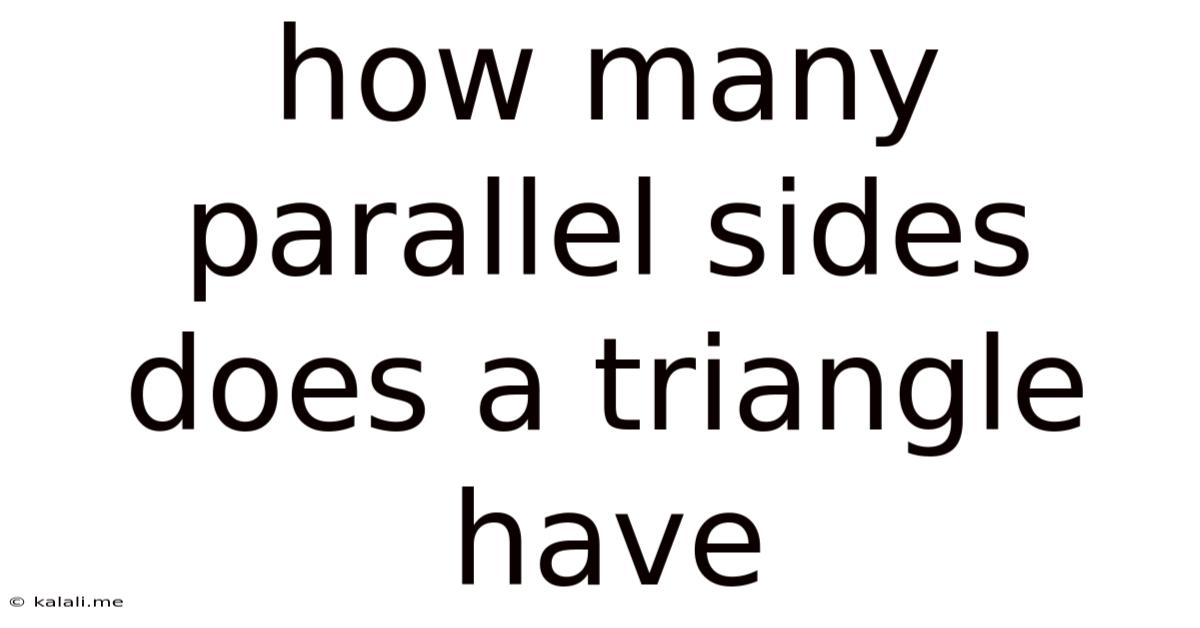How Many Parallel Sides Does A Triangle Have
Kalali
Jul 23, 2025 · 4 min read

Table of Contents
How Many Parallel Sides Does a Triangle Have? A Deep Dive into Geometric Fundamentals
This seemingly simple question, "How many parallel sides does a triangle have?", opens a door to a deeper understanding of geometry, specifically the properties of triangles and the concepts of parallel and intersecting lines. The answer, as we'll soon see, isn't just a single number, but a journey into the fundamental definitions and theorems that underpin Euclidean geometry. This article will delve into the characteristics of triangles, exploring their sides, angles, and relationships to parallel lines, ultimately clarifying the number of parallel sides a triangle possesses. We'll also touch upon related geometric concepts and their practical applications.
Understanding the Basics: Triangles and Parallel Lines
Before addressing the central question, let's establish a firm understanding of the key terms: triangles and parallel lines.
A triangle is a two-dimensional geometric shape defined by three straight lines (sides) that connect three non-collinear points (vertices). These sides form three internal angles. Triangles are classified based on their side lengths (equilateral, isosceles, scalene) and their angles (acute, right, obtuse). The sum of the internal angles of any triangle always equals 180 degrees – a fundamental theorem in Euclidean geometry.
Parallel lines, on the other hand, are lines in a plane that never intersect, regardless of how far they are extended. The distance between them remains constant throughout their length. Parallel lines are often indicated by using symbols like //.
Analyzing Triangle Sides: The Absence of Parallelism
The defining characteristic of a triangle is its three sides. These sides, by definition, connect the vertices and form a closed shape. Crucially, no two sides of a triangle are parallel. If two sides were parallel, they would never intersect, and the third side would be necessary to close the shape, making it impossible to form a triangle as we understand it. Consider attempting to construct a triangle with two parallel lines; the third line would simply be a transversal cutting across the parallels.
Exploring Related Concepts: Transversals and Angles
While a triangle doesn't contain parallel sides, it frequently interacts with parallel lines through the concept of transversals. A transversal is a line that intersects two or more other lines. When a transversal intersects parallel lines, several angle relationships arise, including alternate interior angles, alternate exterior angles, corresponding angles, and consecutive interior angles. These relationships are crucial in proving theorems related to parallel lines and triangles, especially in geometry proofs and constructions.
Triangles and Parallel Lines in Advanced Geometry
The relationship between triangles and parallel lines extends beyond basic geometry. In more advanced concepts such as:
-
Similar Triangles: Similar triangles have corresponding angles that are congruent and corresponding sides that are proportional. These relationships are often established using parallel lines and the properties of transversals. For instance, if two lines are parallel and intersected by two transversals, similar triangles are formed.
-
Projective Geometry: In projective geometry, parallel lines are considered to meet at a point at infinity. This abstract concept helps in understanding the relationship between different geometric perspectives and projections. While seemingly counterintuitive, this allows for consistent treatment of parallel lines within the framework of projective geometry.
-
Coordinate Geometry: In coordinate geometry, parallel lines have the same slope, allowing us to use algebraic equations to represent and analyze their properties. The relationships between the coordinates of vertices of triangles can be used to determine various properties of the triangle, such as its area or centroid.
The Practical Applications of Understanding Triangles and Parallel Lines
The seemingly simple concepts of triangles and parallel lines have widespread applications in various fields, including:
-
Engineering: Understanding the properties of triangles is crucial in structural engineering, where triangular structures provide exceptional strength and stability. Parallel lines are used in designing parallel beams and other structural elements.
-
Architecture: Triangles and parallel lines are fundamental to architectural designs, ensuring stability and aesthetics in buildings and structures.
-
Cartography: Mapping and surveying rely heavily on geometric principles, including triangles and parallel lines, to accurately represent land features and distances.
-
Computer Graphics: Computer graphics and animation extensively use triangular meshes to model and render three-dimensional objects. Parallel lines play a role in creating perspectives and transformations.
Conclusion: Zero Parallel Sides in a Triangle
To definitively answer the initial question: a triangle has zero parallel sides. This is a fundamental characteristic of a triangle, directly stemming from its definition and the inherent properties of its sides and angles. Understanding this seemingly simple concept opens the door to a vast array of more complex geometric theorems, relationships, and applications across many scientific and technical fields. The absence of parallel sides in a triangle underscores the unique nature of this fundamental geometric shape and its crucial role in various disciplines. The investigation into this question offers a foundational understanding of basic geometry and paves the way for exploring more advanced geometric concepts.
Latest Posts
Latest Posts
-
How Much Is 25 Mg In Ml
Jul 23, 2025
-
How Many Gallons Is 35 Pounds Of Oil
Jul 23, 2025
-
Why Is An Interpretation Of A Source Text Important
Jul 23, 2025
-
Which Question Is Most Clearly Analytical In Nature
Jul 23, 2025
-
I Look Forward To Working For You
Jul 23, 2025
Related Post
Thank you for visiting our website which covers about How Many Parallel Sides Does A Triangle Have . We hope the information provided has been useful to you. Feel free to contact us if you have any questions or need further assistance. See you next time and don't miss to bookmark.